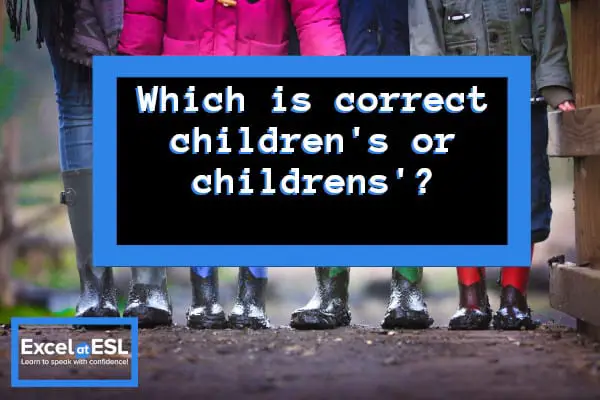The rules for English grammar can seem completely random sometimes. Is it octopuses or octopi? Why isn’t rottweiler spelt as rottwieler if it’s “I before E except after C”? English is full of these types of questions; you probably have a few of them yourself. The correct way to form the possessive for the word “children” happens to be one of these questions. The good news is, if you know the reasons behind why English does something (there’s usually a reason!) then it isn’t so confusing anymore.
“Children’s” is the correct way to form the possessive for the word children. Regular English plurals add ‘S’ to the end of words. You only need to add an apostrophe to avoid a double ‘S’. i.e. dogs becomes dogs’ not dogs’s. Children is already plural, so you would not spell it as childrens’.
Unlike many other instances of different word forms in English, this one doesn’t have an interesting story behind it. The reason why is purely grammatical. In order to better understand why this is, let’s explore the plural forms of English words in depth.
Regular Plurals
All English speakers are familiar with the way to turn most words from one into many. The easiest and most widespread way to do this in English is to take the word and add an “-s” to the end of it.
- kid becomes kids
- pig becomes pigs
- book becomes books
- finger becomes fingers
And so on. The idea is similar for other ways to turn words plural in English. In other cases, you add “-es” to the end of a word when it ends with an X, CH, SH, SS, S, or Z.
- fox becomes foxes
- batch becomes batches
- lash becomes lashes
- process becomes processes
- bus becomes buses
- blitz becomes blitzes
Regular Plural Possessive Forms
The most common way to form the possessive in English is to attach an apostrophe with an S (-‘s) to the end of a word.
- dog becomes dog’s
- fox becomes fox’s
- book become book’s
- latch becomes latch’s
One thing you’ll notice about the regular plural form is that they all end in the letter “S”.
It would be strange (and unnecessary) to add another S to the end of a word that already has one, so these plural words form their possessive form by adding only an apostrophe.
- dogs becomes dogs’
- fox becomes foxes’
- books becomes books’
- latch becomes latches’
In this situation, the plural ending is added first. Afterwards, the possessive ending is added, but it must change to accommodate the S which already exists at the end of the word. The result is that only an apostrophe is added to the end of the word.
This is the way you should look at this formation.
When you build a word like dogs’, you are sticking the endings onto the word like Lego.
- dog + -s + -‘s
However, if we wrote it as “dogs’s”, that would look very silly. Wouldn’t it? This is why the possessive marker loses its S when it attaches to a word that already has one. So, instead of dogs’s we get dogs’.
Irregular Plurals
Because English is English, not all words follow this simple pattern for creating their plural forms. Some words in English signal multiples in an irregular way.
- man becomes men
- goose becomes geese
- person becomes people
- tooth becomes teeth
- mouse becomes mice
- and, of course, child becomes children
These types of words form their plural by changing a vowel sound into a different one (man to men), changing the word (mouse to mice), or adding an ending (child to children).
Irregular Plural Possessive Forms
One thing you will notice about these words is that there is no S at the end of them.
The lack of an S means that the regular possessive ending “-‘s” can attach without any problems. We don’t have to change the form of this ending like we do when the word already ends with an S.
- men becomes men’s
- geese becomes geese’s
- people becomes people’s
- teeth becomes teeth’s
- mice becomes mice’s
- children becomes children’s
If we were to write it as childrens’, we know from the discussion above that we would be adding the plural marker onto the word “child” twice. It would look something like this:
- child + -ren + -s + -‘s
After adding everything together, we would get childrens’, but this construction has two plural markers! You can’t turn a word plural twice, so it doesn’t make any sense to write the possessive form of children this way.
Conclusion
When trying to decide how to form the possessive for an English word, keep in mind if the word is plural or not. If it is, you know that you must add the entire possessive marker (‘s) to the end of the word.
However, if the word already ends in an S, then you know that you must drop the second S in the possessive marker.



